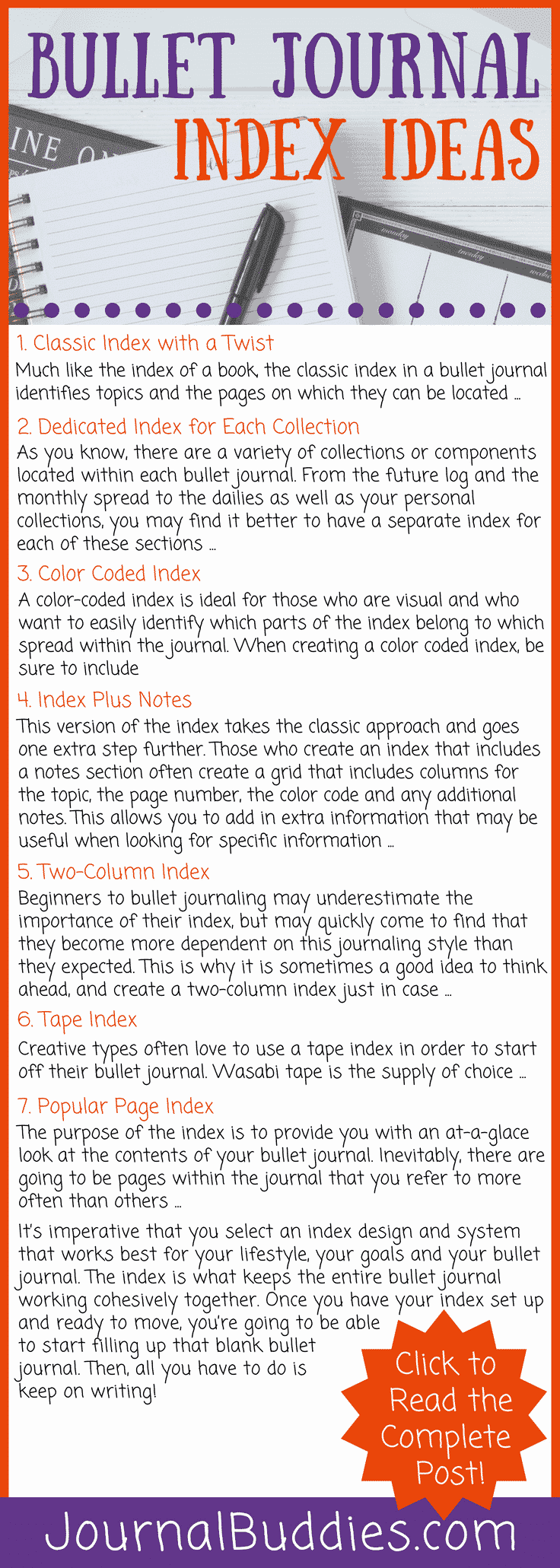Bullet Journaling Index 7 Ideas for you— So, you’ve just decided to pursue bullet journaling and you know that you need to set up the index first. The bullet journal index is essentially an outline of where you can find the information you need within your bullet journal.

Before you start your bullet journal, consider these bullet journal index ideas.
7 Bullet Journal Index Ideas
1. Classic Index with a Twist
Much like the index of a book, the classic index in a bullet journal identifies topics and the pages on which they can be located. For example, if you write about “Girls Night” in your bullet journal, you would log the page numbers in the index in which you mention this phrase. The classic index with a twist is a very basic index, that includes a piece of artwork on the side — such as a sketch or an embellishment. It allows you to personalize the index without impacting its simplicity or effectiveness.
2. Dedicated Index for Each Collection
As you know, there are a variety of collections or components located within each bullet journal. From the future log and the monthly spread to the dailies as well as your personal collections, you may find it better to have a separate index for each of these sections. This allows you to narrow down your search quicker and to stay more organized, especially if you keep a bullet journal that includes many different collections after the dailies. If you opt to go with this index design, you may want to dedicate more than two pages of the journal to the index.
3. Color Coded Index
A color-coded index is ideal for those who are visual and who want to easily identify which parts of the index belong to which spread within the journal. When creating a color-coded index, be sure to include a legend that identifies which color relates to which section, spread, or collection. There are several ways to complete a color-coded index. Some prefer to color code by writing in different colored pens, while others use highlighters to sort the index by color. Those who like to go the extra mile and embellish their bullet journal whenever possible often love this index option.
4. Index Plus Notes
This version of the index takes the classic approach and goes one extra step further. Those who create an index that includes a notes section often create a grid that includes columns for the topic, the page number, the color code, and any additional notes. This allows you to add in extra information that may be useful when looking for specific information within your bullet journal. The index plus notes design is ideal for those who rely heavily on their bullet journal in order to maintain their personal and professional lives.
5. Two-Column Index
Beginners to bullet journaling may underestimate the importance of their index, but may quickly come to find that they become more dependent on this journaling style than they expected. This is why it is sometimes a good idea to think ahead and create a two-column index just in case. A two-column index allows for more topics to be included in the index. It’s the preferred method of those who want to make sure that they can record every topic within their index, as it allows them to record the necessary information without taking about multiple pages within the journal for the index alone.

6. Tape Index
Creative types often love to use a tape index in order to start off their bullet journal. Wasabi tape is the supply of choice when it comes to creating this type of index. Simply use the fun and colorful tape in order to identify the different topics within the index. Some people use the tape to break it down by section or collection, while others use it for each individual topic within the index. The end result is an eclectic index that is not only useful but also interesting to look at.
7. Popular Page Index
The purpose of the index is to provide you with an at-a-glance look at the contents of your bullet journal. Inevitably, there are going to be pages within the journal that you refer to more often than others, which may a popular page index a desirable option for you. With this type of index, you use a highlighter or colored pen to mark the pages within the index that you refer to the most. For example, you may highlight pages 7-8, which contain your shopping lists. Being able to easily identify your most-used sections and pages within your bullet journal will improve the functionality of the book.
It’s imperative that you select an index design and system that works best for your lifestyle, your goals, and your bullet journal. The index is what keeps the entire bullet journal working cohesively together. Once you have your index set up and ready to move, you’re going to be able to start filling up that blank bullet journal. Then, all you have to do is keep on writing!
More Bullet Journal Resources
Until next time, write on…
If you enjoyed these Bullet Journal Index Ideas,
please share them on Facebook, Twitter, and/or Pinterest.
I appreciate it!
Sincerely,
Jill
journalbuddies.com
creator and curator





